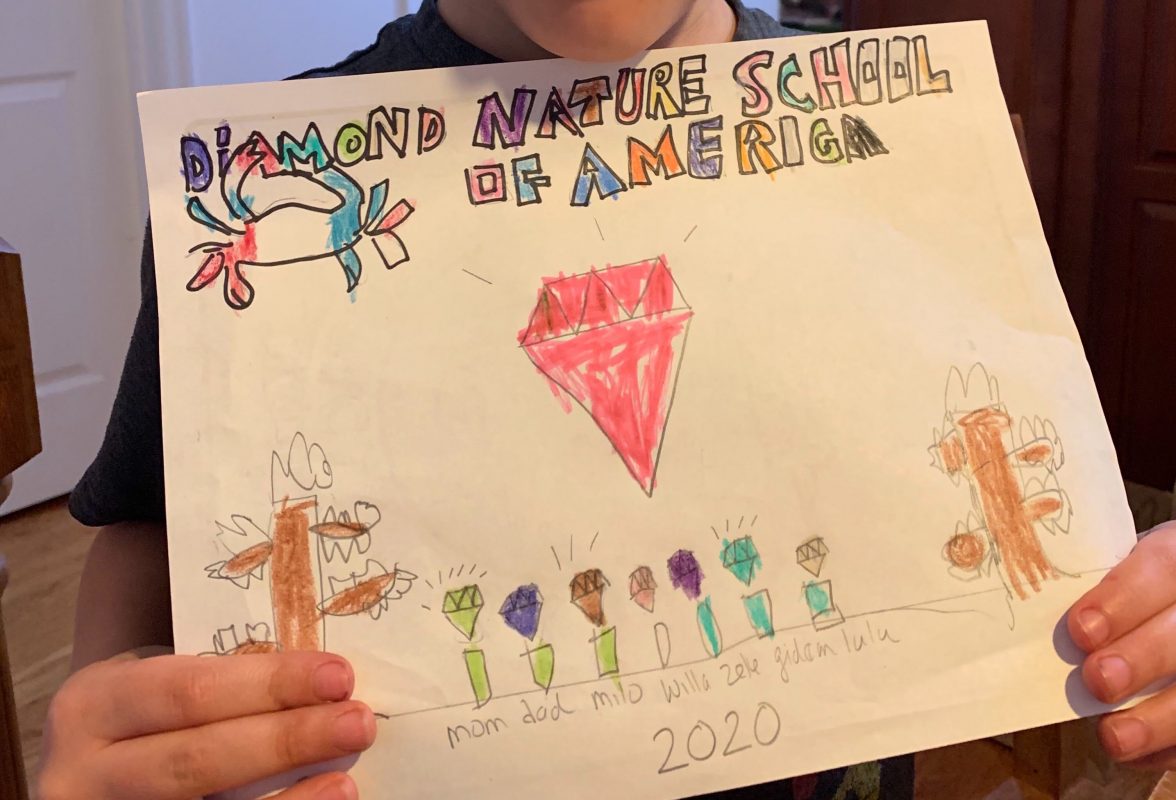
I’m not going to sugarcoat it. This has been hard. We survived a week of adjustments and togetherness (so much togetherness) and that sinking feeling, for this extrovert, of deleting her entire color-coded Google calendar for the foreseeable future.
After an intense family vote, we’ve officially named our homeschool, “The Diamond Nature School of America.” My nine-year-old, Zeke, created a logo and I promised we would make tee shirts at some point. The name is fitting, as we’ve done most of our “schooling” this past week outdoors.
While properly practicing social distancing, we visited the Daniels Area at Patapsco Valley State Park, NCR Trail, Gunpowder Falls South Trail, Beverly Triton Beach Park, Cromwell Valley Park, and Historic Jerusalem Mill Village. Even on the rainy days I make my kids put on their raincoats and take a walk around the block. (“Don’t go near anyone. Don’t touch anything,” I reiterate to them.) Fresh air cures all, for them and for me. A walk in the woods is my Xanax.
But I know there also needs to be some semblance of school. “This isn’t a vacation,” I keep reminding my oldest. (And myself.) But I’m struggling. Four kids, three grades, and one family laptop. (I may have had my 13-year-old write a persuasive essay last week about why he needed Xbox Live.)
So, I reached out to two friends—Jennifer Solomon and Miranda Altschuler—who homeschool by choice to see if they could offer some suggestions to those of us who are homeschooling by being thrown off a cliff.
Solomon and Altschuler both homeschool a gaggle of girls. Solomon’s are 4, 7, and 10, and Altschuler, in addition to a brand-new baby, has an 11, 8, and 5 year old.
“We began homeschooling a few years ago and have never looked back,” Solomon says. “During one particularly enthusiastic moment, I may have even said that homeschooling is just so wonderful, everyone should do it—but I didn’t actually mean it, you guys,” she jokes.
Altschuler adds that, as longtime homeschoolers, her family’s adjustment hasn’t been quite so drastic. But for parents who are finding themselves suddenly homeschooling, she hopes that the following tips help “provide a bit of clarity amidst the chaos.”
1. Our “best” is going to look different every day, and that is just fine.
JS: Some days, everything will fall into place beautifully and your little angels will engage and learn and you’ll Instagram it all (#coronavirusschooling!) and wonder why you haven’t been doing this all along. Other days will be a struggle. They’ll bicker and you’ll snap, and you’ll find yourself rationalizing any and everything as a learning opportunity just so you can be over-and-done-with-it for the day. So we’re just going to try to get through this the best we can.
2. Go easy on yourself!
JS: Lower your self-expectations and demands. You’ve been thrown into a situation that is new and somewhat scary. That friend of yours posting an hour-by-hour recap of “Mommy-Camp Homeschool” may be well-intentioned, but posts like those can really trigger feelings of inadequacy. Right now we are all feeling vulnerable and, frankly, pretty clueless. None of us knows what we’re doing because, well, none of us has ever faced a GLOBAL PANDEMIC before. Now isn’t the time for competitive parenting.
3. Don’t worry about academic regression.
JS: Your kids are not going to fall behind. I repeat: your kids are not going to fall behind. As a global community, we are all in the same boat—albeit a really terrible, careening, lurching boat (definitely getting a one-star Yelp review from me)—together right now. Your child’s emotional and mental health is more important than their academic progress during this time.
4. Don’t try to recreate school at home.
MA: Schooling at home is less formal and takes less time because there are fewer students. Homeschooling should be made to meet the needs and preferences of your family and individual children. Have your students’ list of goals in front of you while you determine how lesson time should be allocated in your home during this unusual stretch of time.
5. You can be flexible with your schooling when that’s what the mood dictates.
JS: Did your kid read a comic book today? BOOM. Reading. Right there. Did you bake a double batch of cookies together to stress-eat later? Nice! Measuring equals math skills. Play a board game? Logic and reasoning! Spend all day outside? Recess! Nature! Tackle chores and laundry? Life skills. Your kids aren’t going to fall behind; they’re just going to learn a little differently for a while.
6. Consider the whole child.
MA: What are your child’s physical, emotional, and academic needs? Younger students need plenty of free play and new math and phonics skills reinforced. Older students may need to study for the SATs and develop life skills they’ll take with them to college. Every child needs responsibilities around the house and time outside.
7. Don’t try to do ALL the things.
JS: One silver lining to this awful situation has been the outpouring of online resources to help teach and occupy our kids. From art tutorials to virtual field trips to read-alouds to yoga classes, we have an unprecedented wealth of resources at our fingertips. Authors, educators, artists, and musicians are showing their true colors and offering countless activities and videos. And that is amazing, and helpful, and generous, but it is also A LOT.
You don’t have to do all the things. You don’t even have to do five of the things. If you happen to do ONE of the things and your kids enjoy it, that’s great, but there is no pressure to do all the fun things, all the time. It’s exhausting.
8. Seek out great materials and resources.
MA: Explore book lists provided by teachers or found online. Take a look at your own bookshelf. Check out ebooks and audiobooks available through your library. Find books that will naturally pique your child’s interest through engaging narratives, not just text books.
9. Involve your children in the planning.
JS: Kids respond really well when we give them a sense of ownership and treat them as though they are actually our fellow human beings (a difficult concept to grasp sometimes, I know). When children and teens feel respected and included, they are less likely to push back. With ownership comes accountability.
10. Follow through, but ease in.
MA: We don’t want to recreate school at home, but we also don’t want a disorienting free-for-all. For the first few days of your plan, just do skill work. Then, every day or two, add a subject. Do one thing well, then try another. These are not normal times, so take it slow and be gentle with yourselves and each other.
11. Prioritize relationships.
MA: Children need structure and freedom, expectations and acceptance. Whether we homeschool or not, our children rely on us to cultivate an atmosphere where they can learn and grow, secure in our commitment to who they are and who they can become. Perhaps this awful situation is also an opportunity, and our families can come out the other side of this experience even stronger.
12. Remember we are in the middle of a public health crisis. We are not in the middle of an academic crisis.
JS: Be gentle with your children and yourself. Stressed adults cannot teach stressed kids. When things get frustrating, walk away. As parents, we are the heart of our family. We set the tone—we’re the family thermostat, if you will. Our kids look to us for safety, security, and love. No one knows how things are going to play out during these uncertain times. As parents, it is our job to cultivate beauty where we can and provide a calm, stable home. A haven. But make no mistake, in the coming months, there will be bickering. Eye rolling. Opposition. Tantrums. Meltdowns. (And that’s just the parents!)
